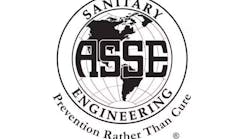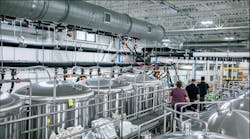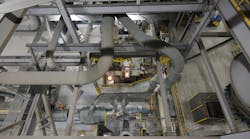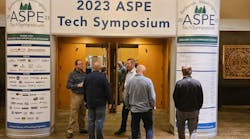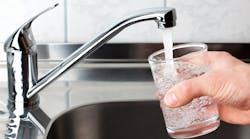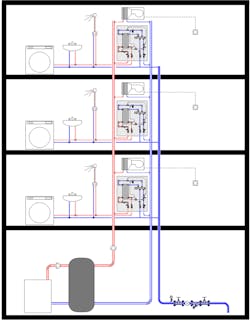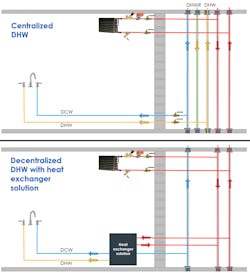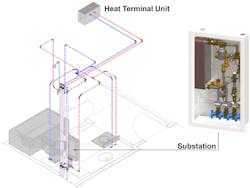Imagine you just poured yourself a glass of tap water to drink. If left unfinished, how long do you let the water sit before you pour it down the drain, and pour yourself a new glass?
What is the longest period of time you would let water sit in your plumbing pipes and still drink it? Do we know how long water sits in our commercial buildings? Can molecules get trapped in circulation without being dispensed?
Water turnover and avoidance of unfavorable temperature ranges are critical factors when engineering domestic systems. The more we can reduce water aging while keeping temperatures in ranges that avoid microbial growth, the safer our water will be.
As one of the most consequential topics in our industry, it is our duty to conserve and preserve a clean and safe water source to maintain a healthy ecosystem needed to support our communities and future populations. In addition to system hygiene, it is extremely important to develop energy and exergy efficiencies and conserve energy by creating more effective systems through new design methodologies and material and equipment selection.
There are growing pressures and incentives to reduce our carbon footprint and accomplish the 2021 White House Executive Orders of achieving a net zero building portfolio by 2045. This includes a 50% emission reduction by 2032, requiring a shift from combustion fuels to more renewable clean energy sources, such as wind and solar.
To meet these challenges during this evolution, we must innovate and adapt to the latest technologies in a planned and strategic manner by defining what is achievable, influencing the industry, and implementing what we can control. We all play a critical role in the creation and adoption of advanced technologies by helping to qualify new innovations and streamlining design, specification, and installation practices using these modern technologies.
In an industry that is slow to change, how can we achieve a net-zero building portfolio in 22 years?
With present processes, after the development of new technologies, it takes an additional decade to introduce solutions into plumbing codes.
With a “have it your way” mentality (thanks, Burger King!), the way we design and install our mechanical and plumbing systems has gone relatively unchanged since the days of Herbert Hoover and Dr. Roy B. Hunter. This remains the status quo today, while many other industries have moved away from individual building customization towards standardization, facilitated by professional engineering and prefabrication.
Sustainability and Rising Energy Costs
Energy efficiency and sustainability are also becoming increasingly important due to rising energy costs, the effort to reduce material and operating carbon in the built environment, and population growth. Our demand on energy systems is increasing, and ultimately, we need to find a way to curb our demand and supply simultaneously, getting more efficiencies out of our current systems and adopting new practices and innovations.
According to the U.S. Dept. of Energy (DOE), “The buildings sector accounts for about 76% of electricity use and 40% of all U.S. primary energy use and associated greenhouse gas (GHG) emissions with major appliances, water heating, refrigerators, freezers, and dryers accounting for 18% of that total…(Therefore) opportunities for improved efficiency are enormous. By 2030, building energy use could be cut more than 20% using technologies known to be cost effective today, and by more than 35% if research goals are met.”
Furthermore, the U.S. Energy Information Administration states that domestic hot water is 20% or more of the energy spent in a multifamily building.
Increased Focus on Hygiene
We know today compounding issues exist in our plumbing systems. Oversized and complex piping networks with reduced fixture flow rates and increased water volumes contribute to aging water and dissipation of water treatment chemicals through the system, resulting in increased bacteria and microorganism growth.
“In the United States, the rate of reported cases of Legionnaires’ disease has grown by nearly nine times since 2000.” (CDC) Now, whether this is environmental or due to increased awareness is debatable; either way, microbial growth is an issue.
To mitigate these concerns, we frequently see efforts such as:
- Adding more chemicals into our potable water, which can negatively impact water quality and system health;
- Increasing the water temperatures to dangerous levels to kill microorganisms, resulting in excessive energy stored and wasted, more components added into the system to mix water temperatures back down to usable levels, and a potential negative impact to system health;
- Copper-silver ionization, which can result in premature corrosion;
- Promotion of frequent system flushing, which wastes water as well as energy on the hot side. In fact, we are seeing more municipalities recommending this method. For example, the city of Chicago states, “It’s particularly important to flush your system for five minutes after it has been stagnant for six hours or more to maintain water quality.”
Answers That Meets Modern Needs
Because every action has a reaction, how do we implement thoughtful strategies that have the greatest positive outcome and mitigate negative impacts? There are other methodologies that we can consider that have been proven and implemented in other parts of the world for decades.
For instance, our European partners have evolved differently to overcome similar water quality issues. The Association of German Engineers' VDI 6023 Hygiene in Drinking Water Installations standard applies to requirements for planning, execution, operation, and maintenance of all drinking-water installations on premises and in buildings.
The first publication of VDI 6023 was released in 1999 for planning considerations for stagnation, water volume, turnover, temperature, and velocity. It recommends that through design and operation, all water must be turned over within 72 hours by means of tapping; dead legs should be minimized, and supply water line volumes must be less than or equal to 3L (0.8 gal). It goes on to state that recirculation volumes greater than 3L (0.8 gal.) require recirculation at 60°C (140°F), and oversizing piping is not allowed and should follow DIN 1988, Codes of Practice for Drinking Water Installations.
If you have been to Europe in the past 20 years, there is a high probability you have washed your hands or showered using hot water generated from a decentralized domestic hot-water (DHW) system that uses a technology called heat-interface units, heat-transfer stations, or substations. These systems are usually engineered, factory-assembled, tested, and certified water-to-water appliances for the generation of DHW when supplied with fluids from a hydronic heating source.
The self-contained unit includes a heat exchanger that converts a building’s hydronic heating supply into on-demand DHW within isolated hot water networks that follow the above considerations.
Decentralized DHW systems with heat-exchanger solutions are gaining attention here in the U.S. as an efficient and sustainable solution for hot-water supply.
Traditional centralized DHW systems are typically operated by generating hot water at a central location and then distributing it through a complex piping network throughout the building.
In contrast, decentralized systems generate hot water at the point of use, simplifying the piping network and often using renewable energy sources to help reduce energy consumption and greenhouse gas emissions. Decentralized systems can also provide greater reliability because they provide hot water closer to the point of use and are thus less prone to breakdowns. This helps ensure each subnetwork has access to hot water, regardless of what happens elsewhere in the system.
In North America, the double-wall heat exchanger (vs. Europe's single-wall model) is a domestic heat source that eliminates the centralized DHW heating system, storage tanks, pumps, recirculation lines, and everything in between. In the mechanical room, these hydronic heating systems can generate heat from boilers, heat pumps, district energy systems, solar, thermal, or any combination of these. Also, “hydronic (liquid-based) systems use little electricity," according to DOE.
Decentralized fresh-water technology systems are beneficial as they are considered on-demand with a heating supply within a maximum of 0.8 gal, equivalent to 87 feet of ½-in. SDR9 pipe, to the end-use fixtures. The units are placed near low-flowing fixture groupings with high concentration density, such as multifamily, hospitality, and assisted living structures.
The technology listed to ASSE LEC 2010-2020 operates via a proportional control valve (PCV) that generates a hot-water supply in proportion to the active demands once the hot-water tap is opened with a 2.5 second (2.5s) charge time on the heat exchanger. If you do the math, simplified sub-networks reduce up to 40% of the DHW piping by eliminating the supply and return piping, resulting in up to 50% savings of the hot-water volume.
That is huge savings in just the piping network, not including the elimination of potential storage tanks. By reducing the overall building water volume, it helps ensure fresh water is evacuating the building faster to improve water quality and hygiene.
There are additional positive system impacts by removing the DHW supply, return lines, and storage tanks, which include saving valuable space, eliminating the corresponding pumps and pumping energy, reducing the amount of energy stored within the system, eliminating standby losses, and reducing system energy costs by up to 35%.
This data is from an internal study by HGA on a 300-room hotel in Minneapolis, MN, which saw 91% average efficiency out of a natural gas condensing boiler by supplying lower return water temperatures. The heat exchanger solution requires lower temperatures, closer to DHW setpoints, to generate hot water on demand and enhances system performance, enabling the boiler system to reach its maximum-rated efficiency by returning cooler water temperatures and improving the efficiencies of the boiler.
Many heat-exchanger solutions provide even more benefits by not using or requiring electricity, gas, venting, or batteries to operate. This eliminates the potential for all that extra material used in the building. It also saves mechanical shaft space, reduces costs, and reduces greenhouse gas emissions.
These compact units are 14.5 in. wide, 25.6 in. high, 5.4 in. deep, and can mount recessed and flush in a 6-inch plumbing wall. They are relatively lightweight at around 50 to 60 lbs., and they help minimize maintenance, and are risk-averse to code changes.
When engineering decentralized DHW with heat-exchanger solutions, consider these factors:
- It consolidates loads for efficiency optimization by reducing down to a single plant in a mechanical room through the elimination of the DHW heater;
- Due to low heating hot water return temperatures, setback is not required;
- The heat terminal units for space heating should consider the temperature profile of the system;
- Eliminating dedicated DHW heaters improves arguments for optimized primary plant redundancies, facilitating planned maintenance, and enabling duty cycling;
- Introduce, if necessary, buffer tanks to stabilize cycling;
- Be aware that the plumbing fixture gallons per minute (gpm) load will transition from the eliminated hot-water supply line to the cold-water supply lines. Domestic-water temperature and pressure controls for each suite are nonelectric and contained within the heat-transfer unit.
The Time to Act is Now
With the ever-changing requirements of energy-efficient, sustainable building design along with human health and hygiene at the forefront of our minds, innovative solutions are necessary to meet the needs of modern living.
Now is the time to move from decades-old, domestic-water systems and evolve toward smarter, more efficient solutions that incorporate innovative design to support a more sustainable future. By incorporating decentralized, fresh-water technology systems, our buildings can benefit from greater efficiency and water conservation, our bodies can benefit from greater hygiene, and our planet can benefit from lower greenhouse gas emissions.
So, are you ready to bring better solutions to your buildings? Are you ready to simplify your domestic-water piping networks and chemical-disinfection strategy by reducing water volumes and temperatures for safer systems with easier system maintenance? Are you ready to move this industry into the future?
North American domestic hot-water generation is finally here. Let’s take this proven technology from around the globe and give our fresh water a one-way ticket on the express riser out of our buildings.
##########
The author is Senior Manager of the Commercial Segment at Uponor. She can be reached at [email protected]. For more on this topic, click here.
Additional Information
ASHRAE Journal Webinar: Exploring Efficiencies of Decentralized DHW Systems https://event.on24.com/wcc/r/3729715/72491EC42374490C5C0D209D30CB15EB
Bean, R., Stotko, A. (2022) Application of District Energy Principles for Enabling Energy and Exergy Efficiency, Conservation of Energy and Mass, and Promoting Safety and Hygiene in Multistory Potable-water Systems. Campus Energy 2022. Boston, MA
https://www.districtenergy.org/campusenergy2022/schedule/conference-program
White paper: Centralized Plants with Decentralized Solutions:
https://uponor.showpad.com/share/tGH27peKjCdJi0lGx2sQY
References
Legionnaires Disease History, Burden, and Trends | CDC. Centers for Disease Control and Prevention. Retrieved April 5, 2023, from https://www.cdc.gov/legionella/about/history.html
Daily Flushing. City of Chicago. Retrieved April 5, 2023, from https://www.chicago.gov/city/en/depts/water/supp_info/winter-weather-and-your-water-system.html
U.S. Department of Energy. Chapter 5: Increasing Efficiency of Building Systems and Technologies. Department of Energy. Retrieved April 5, 2023, from https://www.energy.gov/sites/prod/files/2017/03/f34/qtr-2015-chapter5.pdf
U.S. Department of Energy. Radiant Heating. Department of Energy. Retrieved April 6, 2023, from https://www.energy.gov/energysaver/radiant-heating
Friendly Power. (2020, April 2). Business Energy Advisor. Multifamily Residences. Retrieved April 6, 2023, from https://esource.bizenergyadvisor.com/article/multifamily-residences
White House. (2021, December 8). FACT SHEET: President Biden Signs Executive Order Catalyzing America’s Clean Energy Economy Through Federal Sustainability. The White House. Retrieved April 5, 2023, from https://www.whitehouse.gov/briefing-room/statements-releases/2021/12/08/fact-sheet-president-biden-signs-executive-order-catalyzing-americas-clean-energy-economy-through-federal-sustainability/
##########

